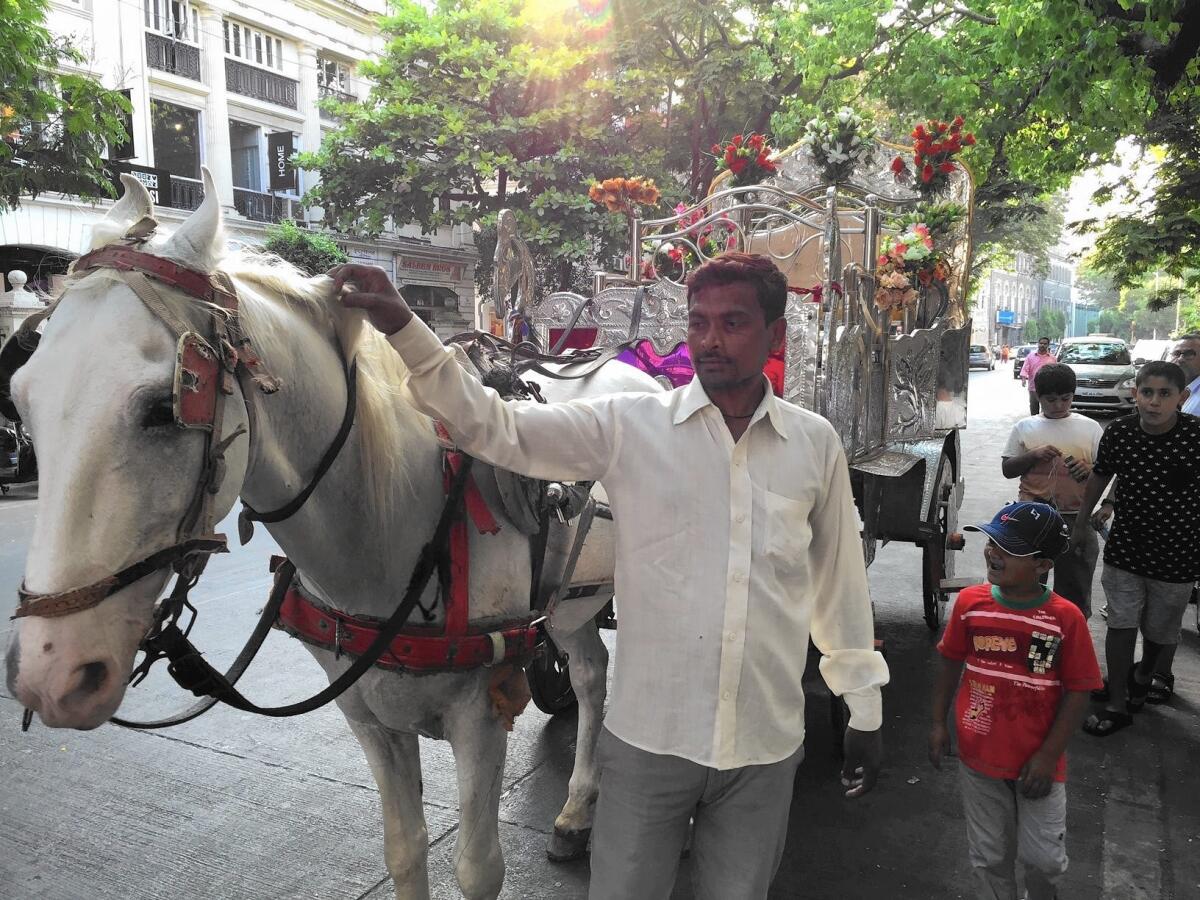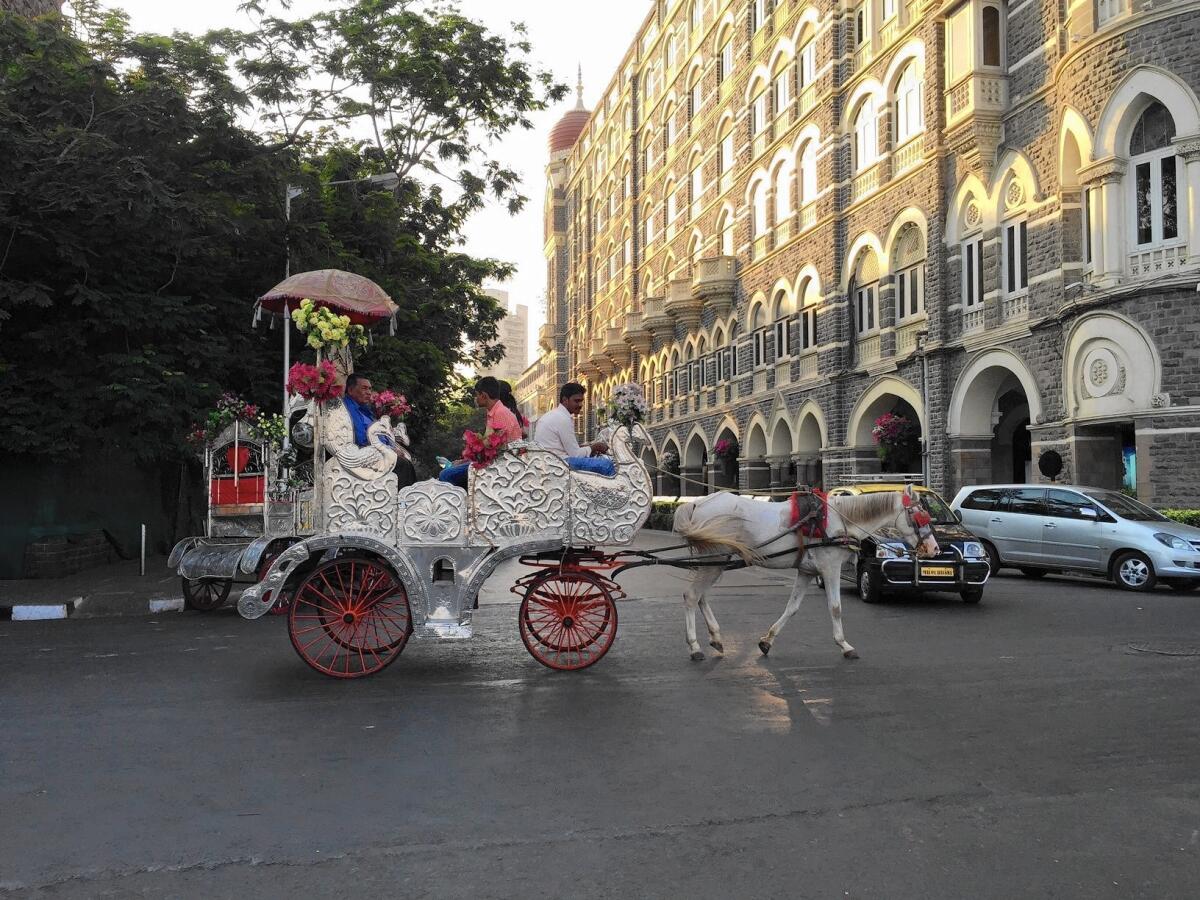Why iconic horse carriages will no longer be allowed on Mumbai’s chaotic streets

- Share via
reporting from MUMBAI, India — Nothing seems to faze 15-year-old Amol as he marches through the pell-mell streets of Mumbai’s historic district: not the pedestrians darting through traffic as if on a dare, not the car horns constantly blaring behind him, not even a derelict red bus that zooms past him at an intersection, nearly knocking him down.
Amol is a horse. For more than a decade, he has towed a carriage through the heart of the city, whisking tourists and lovers past the landmark hotels and crumbling Art Deco facades of old Mumbai.
White-skinned and flaxen-haired — if a bit weary looking — Amol keeps a steady pace in the late afternoon heat amid streams of motorcyclists and black-and-yellow taxis. As the carriage driver, Anees Shaikh, unleashes a stream of tobacco spit off to one side, Amol pulls to a stop at a red light next to a bus full of tourists.
NEWSLETTER: Get the day’s top headlines from Times Editor Davan Maharaj >>
A blond woman sitting in the window points her cellphone camera at Amol and his shiny carriage, encased in aluminum and festooned with artificial flowers, the front molded into the shape of a swan.
“Everyone loves to see the carriages,” Shaikh says over the din of car horns, which Mumbai drivers employ even when waiting at a signal. “Whether or not they go for a ride, the horses make them happy.”

The carriages are a quaint, nostalgia-inducing and sometimes maddening presence in the city’s bursting core. Like those near Manhattan’s Central Park, they share the streets with cars, contributing to rush-hour jams and occasionally making questionable turns.
Yet for decades they have been a symbol of Mumbai, immortalized in Bollywood romances and etched in the popular imagination as a relic of British colonial days.
Soon, Amol will lead his last joy ride around historic Mumbai. The city’s high court last year ordered all carriages off the roads by June, citing the growing safety risks to horses and humans. Animal rights groups had argued the horses were overworked, underfed, suffered bone ailments from plying the tar streets and sometimes sustained injuries in the heavy traffic.
Yes, Shaikh acknowledges, he has been in accidents. Horses have been struck by cars and the metal carriages have been damaged. Mumbai’s streets are immeasurably more chaotic than they were in the late 19th century, when India’s British rulers brought the first carriages to the city then known as Bombay.
The carriages came to be known as Victorias, after the queen. During World War II, Australian soldiers passing through the city would take the reins of the Victorias and race one another through the streets, according to “Taj Mahal Foxtrot,” journalist Naresh Fernandes’ history of the city in the Jazz Age.
After India won independence in 1947, the carriages remained, but as the decades passed and the city grew, they were confined to an ever smaller area. The last 100 or so licensed carriages are restricted to a few downtown blocks.
The light turns green and Amol starts moving again, clip-clopping past a statue of Mahatma Gandhi and then, harrowingly, making a right turn against traffic in front of an elegant red-brick courthouse. Oncoming drivers slow to a stop and Amol’s pace picks up as he eases into a quiet lane lined with flowering trees.
Shaikh’s father and grandfather were carriage drivers. As a boy, he tended to the horses at their stables, in the city’s rundown former red-light district, before starting to drive at age 15. He rejects the contention that the animals are treated poorly.
Now in his 30s, he is unsure what he will do after the carriages disappear from the roads.
“One carriage feeds at least five families,” Shaikh says. “The horses may go to another state and be put to work, but where will we go?”
Amol stops half a block from the Taj Mahal hotel, the elegant red-brick icon overlooking the sea. Several other horses stand at the roadside, munching on buckets of carrots. One driver stares at his reflection in the aluminum, twirling his mustache.
Shilpa Patel, who is visiting from out of town with her parents and two children, descends from a carriage bedecked with faux marigolds.
See more of our top stories on Facebook >>
“Just like in the movies,” Patel says. “It kind of reminds us of the old days, how our parents traveled.”
As Shaikh parks, three pudgy boys appear and begin haggling with him in Arabic. Shaikh, who learned bits of Arabic from ferrying around Saudi tourists, haggles back and the boys go away.
The ride is over. Shaikh takes his fee for the 15-minute trip, about $7.50. He touches the bill to his chest, to the horse’s knee and then to his head, murmuring a small prayer. Stuffing the bill into his pocket, he glances up the road and into the twilight sky, looking for Amol’s next passenger.
ALSO
There’s a new BBC in China -- and there’s nothing British about it
North Korean ships with corpses on board have been washing ashore in Japan
More than 100 dead after fireworks show sparks explosion at temple in southern India
More to Read
Sign up for Essential California
The most important California stories and recommendations in your inbox every morning.
You may occasionally receive promotional content from the Los Angeles Times.











